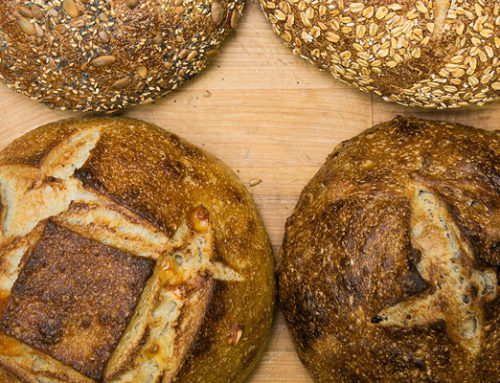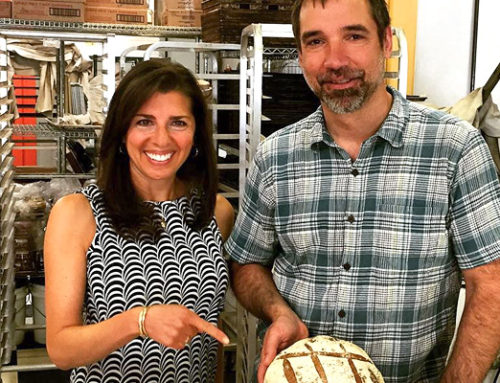The Art of Collaboration
(As published in the Bread Baker’s Guild of America’s journal, Bread Lines, Volume 24, Issue 2)
by Greg Carpenter, Founder, Crooked Tree Breadworks
Long time bakers know that being an artisan baker is not always fun and exciting. When I start noticing signs of burnout in myself I look for new perspectives on baking, either by connecting with other bakers or by injecting some excitement into my bakery’s product line. So when I heard through the Bread Bakers Guild of America that the workshop “Product Development: The Art of Collaboration” was being taught by Team USA 2002 member Tim Healea, owner of little t baker in Portland, Oregon, I immediately signed up.
Tim co-taught the class at the Art Institute of Portland with 2 of his bakers, Dillon DeBauche and Chris Frazier. Dillon and Chris are the kind of employees every bakery owner wishes they had. Competent, creative and committed, they long ago mastered the rules of traditional artisan baking and are now able to break them at will.
And break them we did. Creative experiments have led these bakers to many great ideas. Candy Cap Mushroom Soaker? Why not? Why score fragile whole grain loaves right before they go into the oven when scoring them before they proof can minimize the risk of “deflation”? Why not mix white wine and fennel into a poolish and see what happens? How about hand-propagating some yeast from a bottle of beer to cultivate an Earl Grey tea-infused culture with honey?
Tim intentionally encourages his bakers to create. From developing a concept, to making a formula to “editing” products, he maximizes the unique skills of his team by ”playing to their strengths.” Says Tim ”Some are good with ideas, some are good with evaluations. They have the tools and the facility. I just have to let them go wild! ”
Dillon’s passion is for creating and combining flavors. As he explains it: “I start with manipulating unique flavors and ingredients and then I find a way to work them in to a texture. You may not be able to taste the individual flavor components, but combined they create a unified whole, almost like a stew”. This was demonstrated in the Pumpkin Seed Currant Bread we baked, which highlighted the use of Buckwheat honey (Dillon says “I love the “barnyardy” aroma of this stuff!”) and corn flour to play off the intensity of the Red Fife wheat and rye starter, and the Khorasan flour in the final dough. The resulting flavor was deliciously unlike any I’ve experienced before.
Many of the formulas we followed in class used multiple preferments, soakers or porridges. For instance, the Durum, White Wine, and Fennel Seed Baguette formula used a special poolish to develop the flavors of the wine and fennel (with a touch of Red Fife wheat). This was combined with a white levain that did the “heavy lifting” and provided the textural backbone of the loaf. In this instance the poolish acts as an infusion/ textural enhancement.
Using grains such as Teff, Khorasan, Spelt and Rye opens doors to many new possibilities, but bakers must accommodate the unique characteristics of these grains in order to fully realize their potential. One technique we used in class was particularly interesting to me: “denaturing” the enzymes in a whole grain before building a levain. The Teff Sourdough that we made included a levain made from whole Teff flour and apple cider. Left unchecked this will ferment like wildfire, but by pouring scalded apple cider over the Teff flour one can denature the enzymes, allowing fermentation to proceed at a much more controllable rate. Clever.
“One of the cool things about collaborating is getting an awareness of contrasting styles” said Chris, whose skills are a perfect complement to Dillon’s . He likes to play different flavors and textures against one another and has the technical proficiency to do it. His skills were evident when “in the interest of overpromising and under delivering” Tim decided to add one more bread on the second day; Buckwheat with Currants with Hazelnuts. When Chris tried to pull it from the mixer it clearly did not look the way it was supposed to; it was soupy and underdeveloped, the kind of dough that has deflated the hopes of many of us at one time or another. Unfazed, Chris nurtured the dough into shape over the course of its fermentation through a series of small manipulations, rests and folds. The loaves turned out beautifully. “Sometimes the best products come from mishaps” said Tim.
Meeting and baking with Tim, Dillon and Chris was inspirational, informative and a lot of fun. As I munched on my loaf of Buckwheat Currant Hazelnut bread (which beat the heck out of the hotel breakfast bar) I looked anew at the tools and staff I had waiting in the bakery back home. I couldn’t wait to get back and brainstorm with the bakers.











